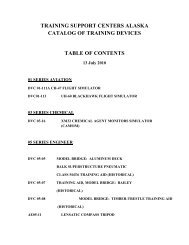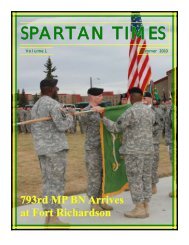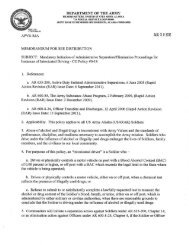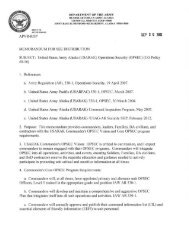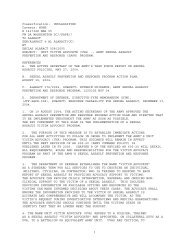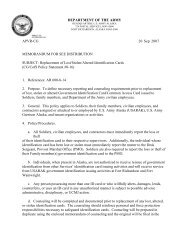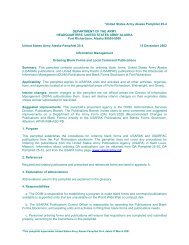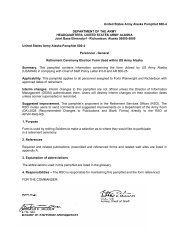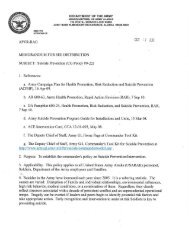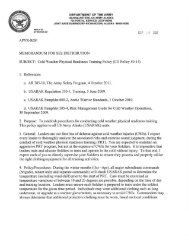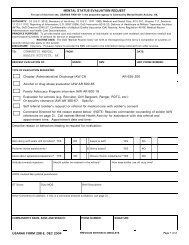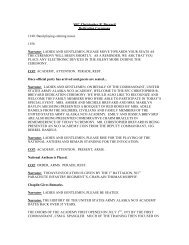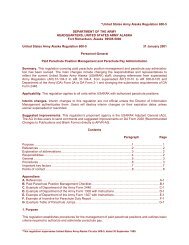Homesteads on Fort Richardson, Alaska - The USARAK Home Page ...
Homesteads on Fort Richardson, Alaska - The USARAK Home Page ...
Homesteads on Fort Richardson, Alaska - The USARAK Home Page ...
- No tags were found...
You also want an ePaper? Increase the reach of your titles
YUMPU automatically turns print PDFs into web optimized ePapers that Google loves.
profitable. 32 Ohls<strong>on</strong> tried, as had his predecessor, Noel W. Smith, to stir interest inagricultural development of the Matanuska Valley to increase freight opportunitiesfor the <strong>Alaska</strong> Railroad. He set up an office in Chicago to promote immigrati<strong>on</strong> tothe area. M.D. Snodgrass was in charge of the experimental farm at Matanuska andtraveled the country searching for people to relocate to <strong>Alaska</strong>. <strong>The</strong> area receivedlittle attenti<strong>on</strong> or success until the mid 1930s. 33<strong>The</strong> 1932–33 <strong>Alaska</strong> Directory and Gazetteer provides this descripti<strong>on</strong> of Anchoragein its introducti<strong>on</strong>:AnchoragePop. 2277. An incorporated town at the head of Cook’s Inlet. Oneof the most modern towns in the territory, with its own teleph<strong>on</strong>e,water, electric light and sewer systems, public schools, banks,churches and beautiful homes. Here are the shops and headquartersof the <strong>Alaska</strong> Railroad, 114 miles from Seward, its terminal.Anchorage is the center of many industries such as quartz and placermining, coal mining, fishing and fish canning, some fur trappingand fur raising. 34Though the town was not the bustling beehive of activity it <strong>on</strong>ce had been, thingswere tolerable enough in the 1930s. Anchorage did not suffer from the Depressi<strong>on</strong>as severely as the rest of the country. <strong>The</strong> Territory benefited from several federalrelief projects and increased gold mining activities in Talkeetna. <strong>The</strong> New Deal’srelocati<strong>on</strong> of farmers to the Matanuska Valley brought more people to the city andstimulated some business for the railroad. 35In all, the booms and busts of Anchorage populati<strong>on</strong>s are reflected in the number ofhomesteaders found in the <strong>Fort</strong> Richards<strong>on</strong> area from 1914 to 1941. Railroad c<strong>on</strong>structi<strong>on</strong>initially brought people to the Anchorage area. <strong>The</strong>n as the populati<strong>on</strong>,ec<strong>on</strong>omy and railroad activity declined in the 1920s and early 30s so too did homesteadingactivities. <strong>The</strong> Anchorage populati<strong>on</strong> would not significantly increase untilthe late 1930s, when World War II played a major role in stimulating permanentgrowth and development of the territory.32<strong>Alaska</strong> Railroad History Timeline. Available: http://www.akrr.com/History/timeline.html33Miller. <strong>The</strong> Fr<strong>on</strong>tier in <strong>Alaska</strong> and the Matanuska Col<strong>on</strong>y. pp. 28-30.34<strong>Alaska</strong>: Directory and Gazetteer, 1932-1933. Published in Seattle, Washingt<strong>on</strong>.35Tower. Anchorage, From it’s Humble Origins as a Railroad C<strong>on</strong>structi<strong>on</strong> Camp. pp. 67-68.<str<strong>on</strong>g><strong>Home</strong>steads</str<strong>on</strong>g> <strong>on</strong> <strong>Fort</strong> Richards<strong>on</strong><strong>Alaska</strong>13



